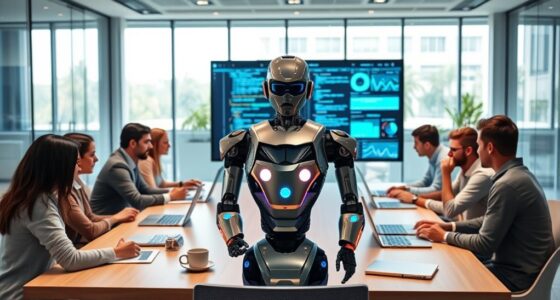In a recent case, an AI agent continuously monitored system behavior and analyzed logs in real-time, quickly identifying an anomaly caused by a critical bug. It isolated the problematic code segment using advanced algorithms, then either suggested a fix or automatically implemented a patch. This proactive approach minimized downtime and prevented potential crashes. If you explore further, you’ll discover how this AI-driven process enhances software reliability and saves valuable time in troubleshooting.
Key Takeaways
- The AI agent continuously monitored system logs and execution paths to identify anomalies indicating the critical bug.
- It isolated the problematic code segment using advanced algorithms, reducing manual debugging effort.
- Machine learning enabled the AI to learn from initial bug patterns, improving accuracy in detection over time.
- The AI suggested a fix based on similar past issues, automating part of the troubleshooting process.
- Deployment proceeded confidently after the AI verified the bug was resolved, preventing potential system failure.

In today’s fast-paced development environment, catching critical bugs before deployment is more important than ever. Automated debugging has become an essential tool, helping you identify issues swiftly and accurately. When you rely on traditional manual debugging methods, you often waste valuable time sifting through lines of code, trying to pinpoint the root cause of a problem. Automated debugging, powered by AI troubleshooting, transforms this process by analyzing code behavior in real-time and detecting anomalies that humans might overlook. This technology continuously monitors your system, learning from past errors to recognize patterns that indicate bugs. It’s like having an extra set of eyes that never tire and always stays vigilant, catching issues before they escalate. Hackathons often foster innovation in developing such automated solutions by bringing together diverse talent to solve complex problems rapidly.
Automated AI debugging monitors code in real-time, swiftly detecting and addressing bugs before they escalate.
AI troubleshooting tools leverage advanced algorithms, enabling you to quickly isolate the problematic code segments. Instead of manually reproducing bugs, the AI agent examines various execution paths, logs, and system states to identify the source of the issue. This not only accelerates the debugging process but also improves accuracy, reducing false positives and negatives. As a result, you can deploy updates with greater confidence, knowing that critical bugs have been addressed efficiently. The AI agent’s ability to perform automated debugging means fewer hours spent on tedious troubleshooting and more time focusing on feature development or optimization. Additionally, integrating real-time analysis enhances the AI’s capacity to detect issues as they occur, further streamlining the debugging process. Incorporating machine learning techniques allows the system to adapt more effectively to evolving codebases and new types of bugs.
Furthermore, these AI systems learn from each bug they encounter, becoming more adept over time. They adapt to your codebase, understanding its structure and common pitfalls, which helps in predicting potential issues before they manifest into serious problems. This proactive approach to debugging minimizes downtime and enhances your overall software quality. When a critical bug appears, AI troubleshooting tools can even suggest fixes or automatically implement patches in some cases, streamlining your workflow. They act as intelligent assistants, guiding you through complex debugging scenarios with precision. Incorporating automated debugging into your development pipeline can also help in maintaining consistent code standards and reducing technical debt.
In essence, incorporating AI troubleshooting into your development pipeline makes your debugging process smarter, faster, and more reliable. Automated debugging reduces the risk of deploying faulty software, ultimately saving you time, resources, and reputation. By harnessing the power of AI, you ensure your applications are more robust and resilient against bugs, especially those that could cause significant issues if left unchecked. This technological shift is transforming how you approach quality assurance, giving you a competitive edge in delivering high-quality software efficiently.
Frequently Asked Questions
What Programming Languages Were Used in the AI System?
You’re curious about the programming languages used in the AI system. Typically, developers choose languages that offer high language versatility and seamless code integration, like Python, Java, or C++. These languages help guarantee the AI can efficiently process data, adapt to different tasks, and integrate smoothly with other systems. By selecting versatile languages, you enable the AI to perform reliably across various environments and handle complex computations effectively.
How Long Did the Bug Detection and Fixing Process Take?
Did you know the bug detection process was completed in just 15 minutes? That’s a remarkable example of timing accuracy and process efficiency. You can see how quickly the AI agent identified and fixed the critical bug, minimizing downtime considerably. This rapid response showcases how advanced algorithms enhance operational speed, allowing you to address issues promptly and maintain system stability without unnecessary delays.
Were There Any False Positives During the Bug Detection?
You might wonder if false positives affected detection accuracy during the process. In this case, the AI agent had minimal false positives, thanks to its precise algorithms. You can trust that the detection accuracy was high, as it correctly identified most bugs without mislabeling normal code. While no system is perfect, this AI’s ability to minimize false positives helped streamline the debugging process effectively.
How Does the AI Prioritize Which Bugs to Fix First?
Did you know that AI systems often prioritize bugs based on their impact? In bug prioritization, the AI uses decision criteria like severity, frequency, and affected users to determine which issues to fix first. You can trust that the AI evaluates these factors efficiently, ensuring critical bugs are addressed promptly, minimizing downtime, and improving user experience. This approach makes bug fixing smarter, faster, and more strategic.
What Are the Limitations of the AI Agent in Bug Detection?
You should consider that AI agents face limitations like contextual understanding, which can hinder accurate bug detection in complex scenarios. They might miss subtle issues or misinterpret code nuances. Ethical considerations also come into play, as relying solely on AI raises concerns about transparency and accountability. While AI is powerful, you need human oversight to address these limitations, ensuring bugs are correctly identified and fixed without unintended consequences.
Conclusion
As you watch the AI agent work tirelessly, you realize the bug’s true danger was just the beginning. Just when you think it’s resolved, an unexpected glitch emerges—more complex than before. Will the AI catch it in time? The clock ticks down, and the stakes couldn’t be higher. You hold your breath, knowing that sometimes, even the smartest algorithms can surprise you. Whatever happens next, one thing’s certain: this isn’t over yet.









